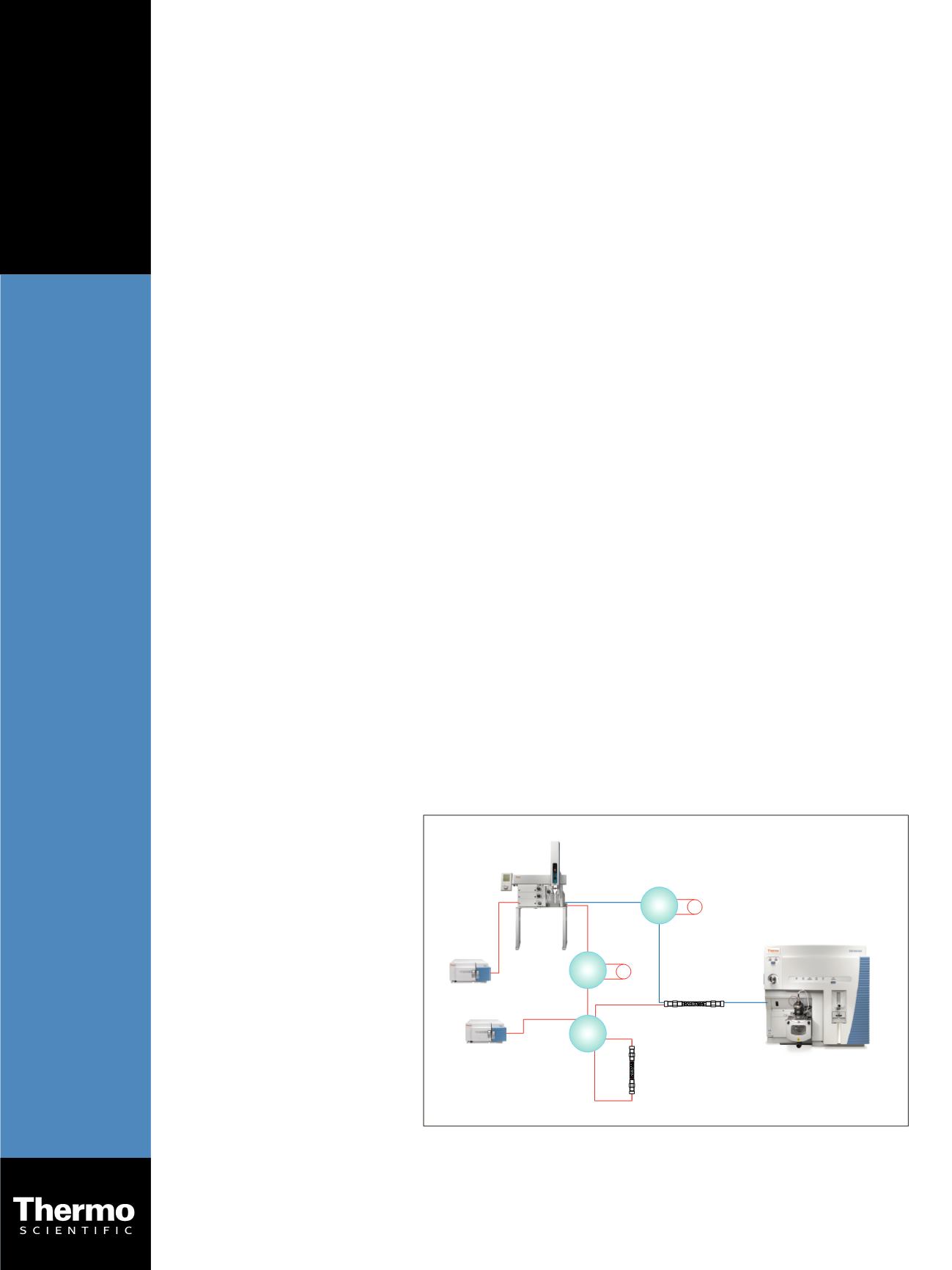

Quantification of EPA 1694 Pharmaceuticals
and Personal Care Products in Water at the
ng/L Level Utilizing Online Sample Preparation
with LC-MS/MS
Kevin McHale, Mark Sanders; Thermo Fisher Scientific, Somerset, NJ
Introduction
There is growing environmental concern regarding the
health impact of trace levels of pharmaceuticals and
personal care products (PPCPs) in water resources. In
response to this concern, the U.S. Environmental Protec-
tion Agency (EPA) recently published Method 1694, which
determines dozens of PPCPs in water, soil, sediment, and
biosolids by high performance liquid chromatography
combined with tandem mass spectrometry
(HPLC-MS/MS).
1
The method, which is yet to be
promulgated, uses solid phase extraction (SPE) of water
samples followed by HPLC-MS/MS analysis using a single
transition for each compound to achieve low nanogram/
liter (ng/L) limits of quantitation (LOQs).
The target analytes in the EPA method are divided into
four groups, with each group representing one
HPLC-MS/MS run. Three of the groups are extracted
under acidic conditions; the fourth is extracted under
basic conditions. These SPE methods can use up to 1 L of
sample. Although not sample limited, the storage of large
bottles of water requires a great deal of refrigeration space.
In addition, manual SPE of 1 L of sample requires several
hours of preparation.
One of the opportunities in the analysis of PPCPs in
water is to reduce the time required for sample prepara-
tion and analysis while maintaining the required sensitivity
at the ng/L level and the selectivity to positively identify
the analyte of interest. We describe
a method for online sample prepara-
tion and analysis using the Thermo
Scientific EQuan system. This method
couples a fast HPLC system with two
LC columns – one for pre-concentra-
tion of the sample, the second for the
analytical analysis – and an LC-MS/
MS instrument. Instead of processing
1 L of water by the manual, time-
consuming process of SPE described
in EPA Method 1694, this alternative
approach incorporates online sample
preparation in series with LC-MS/
MS using smaller volumes of water
(0.5-20 mL) to achieve ng/L quantita-
tion limits.
Goal
To demonstrate a progressive approach to analyzing PPCPs
in environmental sources of water at the ng/L level with
online sample preparation using small volumes of water,
thus saving time and reducing the cost of analysis.
Experimental Conditions
The EQuan LC-MS/MS experimental setup is illustrated in
Figure 1.
Sample Preparation
Aqueous solutions containing 5% – 20% acetonitrile
(ACN) and adjusted to pH 2.9, 6.6 or 11.3 were spiked
with more than 60 PPCPs at the low ng/L level.
HPLC
Water samples of 0.5 mL were directly injected onto a
Thermo Scientific Hypersil GOLD aQ pre-concentration
trapping column (2.1 x 20 mm, 12 µm) at 1.5 mL/min
with H
2
O + 0.2% formic acid. After sufficient washing of
the pre-concentration column, the target compounds were
transferred to the Thermo Scientific Betasil C18 analyti-
cal column (2.1 x 100 mm, 3 µm) for chromatographic
separation by gradient elution prior to introduction into
the mass spectrometer.
Application
Note: 508
Key Words
• EQuan System
• TSQ Vantage
• PPCPs
• Water Analysis
Autosampler
3µmBetasil18
AnalyticalColumn
12µmHypersilGOLDaQ
Preconcentration
Column
Large
Volume
Sample
Loop
6-Port
Valve
6-Port
Valve
Accela600
Pump
Accela1250
Pump
Conventional
VolumeSample
Loop
6-Port
Valve
TSQVantageTripleStage
QuadrupoleMassSpectrometer
Figure 1. The EQuan pre-concentration LC-MS/MS experimental setup.



















